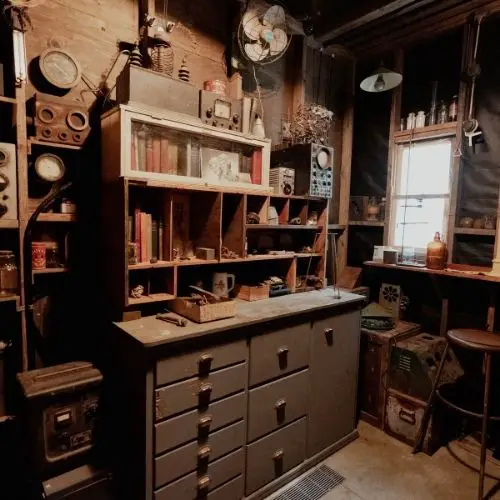We may get commissions for purchases made through links in this post. Thanks for the support! 👍
What you put under your garage cabinets is a question that comes up often. Most people ask if they should use plywood or MDF, and many want to know what the best product on the market is for doing this. There are a lot of products available from different manufacturers that can do this job for you. Still, one is the cheapest and most effective solution for this job – foam rubber insulation board.
Garages built on concrete slabs are standard for most homes. Contrary to popular belief, installing storage cabinets in your garage is possible even if the floor is made of concrete. The only important factor is that the product chosen should be able to carry 400 pounds per square foot (PSF).
As you may already know, garage spaces are often cramped and cluttered. This can be attributed to a lack of storage space.

So what do you put under garages cabinets on concrete? Concrete floors need not stop you from getting organized. You can quickly increase floor space by installing overhead cabinets or racking systems for storing frequently used items such as tools, sporting equipment, garden supplies and more.
Before choosing a storage solution, it is essential to understand the various types of garage flooring and their suitability for installation purposes. One of the most popular garage floors is concrete because it is durable and easy to clean compared to other materials such as asphalt. A concrete slab provides a sturdy base for cabinets, but this can pose problems if you intend on installing racking systems or shelves that sit directly on the floor.
Concrete is particularly challenging because it varies in strength and density. Some areas may be soft and crumbly, while others are made up of dense, unyielding material, making drilling difficult and potentially dangerous without applying some form of the masonry drill bit into the surface.
When dealing with a concrete floor, always remember that weight capacity plays a significant role in determining what you can and cannot put under garages cabinets on concrete. There are plenty of storage solutions to choose from, so you should be able to find one that suits both your budget and needs.
Suppose you expect heavy items such as motorbikes, power tools and sports equipment to be stored inside the cabinet. In that case, it is advisable to allocate a larger area for racking systems. Pegboards and wire shelving work very well for smaller spaces that require less than 200 pounds per square foot (PSF). All items should be appropriately labelled for easy retrieval later on.
Of course, nothing beats having a designated space where every item has its assigned slot or drawer. This tidying up a breeze because you can quickly look for a specific item instead of moving several boxes and the entire racking system to find that special screwdriver.

Regardless of what type or style you choose, always remember that storage cabinets will need solid support from underneath. The best way to do this is by assembling the cabinet on the ground and then sliding it into place until all four legs make contact with the floor. This is particularly important when dealing with concrete because you cannot rely solely on the cabinet’s weight in distributing its load across various points on your garage floor.
If you prefer easy access and less effort in hooking each knob when sliding doors, then you should consider installing two sets of tracks at an equal distance from each other. You can also do this to increase the door’s weight capacity without using heavy-duty materials, which may not be suitable for thinner cabinets.
You can install cabinets on concrete floors by following these essential tips:
- Use masonry drill bits when drilling holes for pre-drilling screw or bolt holes
- Always choose cabinet designs with a weight capacity of at least 200 pounds per square foot (PSF)
- Combine two sets of tracks to provide easier access and installation
- Place each cabinet leg on pre-installed plastic pads
- Securely fasten cabinets to the floor using lag bolts or screws
- Cover any sharp edges with self-adhesive rubber bumpers
- Stabilize racking systems by securing them onto the wall or ceiling.
If in doubt, always consult with a professional to avoid accidents and injuries when installing racking systems in your garage.
This article is sponsored by a popular online DIY store ( www.diy.com ) – the place for everything you need to make your life easier.

